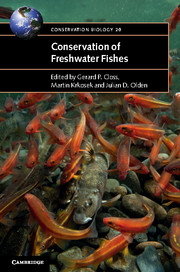Book contents
- Frontmatter
- Contents
- List of contributors
- Preface
- 1 Lost fishes, who is counting? The extent of the threat to freshwater fish biodiversity
- 2 Why are freshwater fish so threatened?
- 3 Climate change effects on freshwater fishes, conservation and management
- 4 Challenges and opportunities for fish conservation in dam-impacted waters
- 5 Chemical pollution
- 6 Multiple stressor effects on freshwater fish: a review and meta-analysis
- 7 Infectious disease and the conservation of freshwater fish
- 8 Non-indigenous fishes and their role in freshwater fish imperilment
- 9 Riparian management and the conservation of stream ecosystems and fishes
- 10 Fragmentation, connectivity and fish species persistence in freshwater ecosystems
- 11 Conservation of migratory fishes in freshwater ecosystems
- 12 Protecting apex predators
- 13 Artificial propagation of freshwater fishes: benefits and risks to recipient ecosystems from stocking, translocation and re-introduction
- 14 Freshwater conservation planning
- 15 Sustainable inland fisheries – perspectives from the recreational, commercial and subsistence sectors from around the globe
- 16 Understanding and conserving genetic diversity in a world dominated by alien introductions and native transfers: the case study of primary and peripheral freshwater fishes in southern Europe
- 17 Maintaining taxonomic skills; the decline of taxonomy – a threat to fish conservation
- 18 Synthesis – what is the future of freshwater fishes?
- Index
- References
5 - Chemical pollution
Published online by Cambridge University Press: 05 December 2015
- Frontmatter
- Contents
- List of contributors
- Preface
- 1 Lost fishes, who is counting? The extent of the threat to freshwater fish biodiversity
- 2 Why are freshwater fish so threatened?
- 3 Climate change effects on freshwater fishes, conservation and management
- 4 Challenges and opportunities for fish conservation in dam-impacted waters
- 5 Chemical pollution
- 6 Multiple stressor effects on freshwater fish: a review and meta-analysis
- 7 Infectious disease and the conservation of freshwater fish
- 8 Non-indigenous fishes and their role in freshwater fish imperilment
- 9 Riparian management and the conservation of stream ecosystems and fishes
- 10 Fragmentation, connectivity and fish species persistence in freshwater ecosystems
- 11 Conservation of migratory fishes in freshwater ecosystems
- 12 Protecting apex predators
- 13 Artificial propagation of freshwater fishes: benefits and risks to recipient ecosystems from stocking, translocation and re-introduction
- 14 Freshwater conservation planning
- 15 Sustainable inland fisheries – perspectives from the recreational, commercial and subsistence sectors from around the globe
- 16 Understanding and conserving genetic diversity in a world dominated by alien introductions and native transfers: the case study of primary and peripheral freshwater fishes in southern Europe
- 17 Maintaining taxonomic skills; the decline of taxonomy – a threat to fish conservation
- 18 Synthesis – what is the future of freshwater fishes?
- Index
- References
Summary
INTRODUCTION
Chemical forms of water pollution are a major cause of freshwater habitat degradation worldwide. There are many sources of toxic contaminants, and these reflect past and present human activities and land uses. Toxics can have adverse health impacts on all components of aquatic ecosystems, including threatened fish species and the biological communities they rely on, particularly for food. Toxics can also interact in complex ways with other non-chemical habitat stressors such as water temperature, disease vectors and non-native species (Chapter 2). Therefore, chemical pollution poses important challenges for the conservation of freshwater fish and their habitats. The pollution problem scales roughly in proportion to the global human population, and is therefore expected to grow in significance throughout many parts of the world in the first half of the twenty-first century.
This chapter provides an introduction to freshwater pollution science, with an emphasis on current and emerging threats to vulnerable fish populations. There are now more than 80,000 individual chemicals in societal use, derived from commercial product manufacturing, drug development, pest control practices and many other processes that underpin modern economies. A large fraction of these chemicals eventually ends up in aquatic habitats via direct discharges, land-based run-off and atmospheric deposition. An overview of water quality threats on a chemical-by-chemical basis is impracticable. Rather, we will focus on central themes in freshwater ecotoxicology and common challenges for the conservation and recovery of threatened fish. Additional important categories of water pollution are beyond the scope of this chapter. For more information on these other topic areas, the reader is referred to reviews on nutrients and sediments (Bouwman et al., 2013), acid rain (Schindler, 1981), microbial pathogens (Ferguson et al., 2003) and natural toxins produced by biological organisms (e.g. microcystins from cyanobacteria; Landsberg, 2002).
Several core concepts in aquatic ecotoxicology are provided in Table 5.1. These terms are generally used to draw distinctions between contaminants that: (1) are historical use (legacy) vs. modern use, (2) are released from focal vs. diffuse sources, (3) are short-lived vs. persistent in the environment, (4) are metabolised and eliminated by organisms vs. passed through food webs to higher trophic levels, (5) impact fish directly vs. indirectly via loss of prey, (6) are acutely lethal (i.e. cause fish kills) vs. causing more nuanced sublethal toxicity, and (7) have effects on fish at the individual vs. the population scale.
- Type
- Chapter
- Information
- Conservation of Freshwater Fishes , pp. 149 - 177Publisher: Cambridge University PressPrint publication year: 2015
References
- 2
- Cited by



